Notable trees
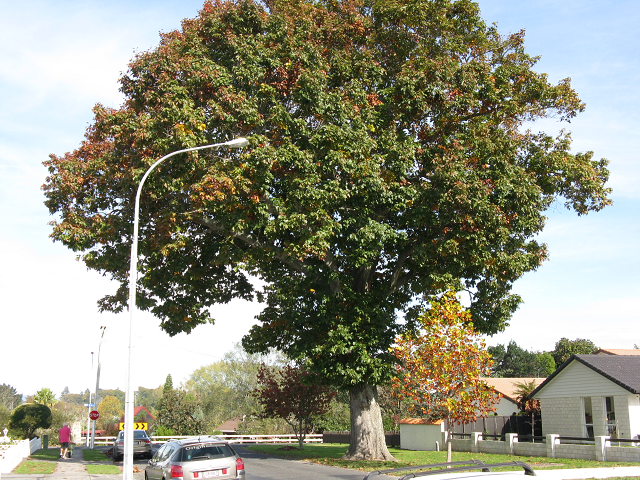
Quercus rubra
Not to be confused with Q. robur, the common English oak, this handsome, stately tree is a native of eastern and central North America and can be found from Nova Scotia to Louisiana and as far west as Oklahoma. It is widely considered a national treasure in the USA and is the State tree of New Jersey.
Growing in the forests of North America, it can reach a height of more than 40 metres and may live 500 years. It is tolerant of salt and air pollution and relatively tolerant of soil compaction which makes it suitable for street and park planting, although in this situation it seldom grows as high but is valued for its rich autumn colour. Also, since the 19th century Q. rubra has been used in forest plantings in Europe, where it may take 20 years to produce flowers and another 20 before it produces a good crop of acorns. It has large leaves whose lobes terminate with bristle-pointed teeth, and on young trees the bark is silver-grey and smooth, but when mature red oak can be distinguished from other oaks by the shiny stripe down the centre of its bark ridges.
Q. rubra is one of the most important oaks in the USA for timber production, its reddish-brown wood is valued for flooring, veneer, interior trim and furniture. The wood has a tendency to absorb moisture making it unsuitable for boatbuilding and exterior trim, but it is nevertheless sometimes used for fence posts and railroad ties.
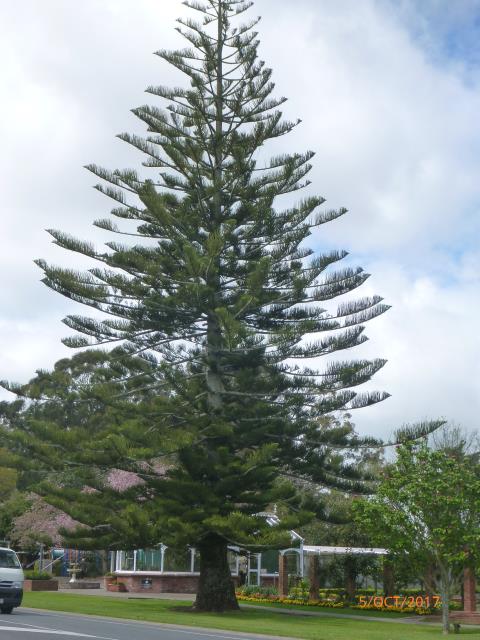
Araucaria heterophylla/excelsa
This is the beauty of the Araucaria family. A group of trees that encircle the Pacific Ocean, they include 13 different Pacific Island members of the genus, as well as the Chilean monkey puzzle, the Queensland bunya bunya pine, the Chinese and Japanese Cryptomerias, and several Tasmanian species, all of which are genealogically related to the giant sequoia of the western USA! All of them share a somewhat reptilian appearance with their bright green scaly leaves.
Standing alone in a garden, these sorts of trees often look stiff and out of place, whereas planted in clumps (or in their naturally occurring forests) they are magnificent. The monkey puzzle was, for a time, the darling of late Victorian England where it was often combined with ‘bogus-rustic arbours and geometrical beds of scarlet salvias.’ At much the same time in the USA, Brazil, Peru, and British colonies of the South Pacific the Norfolk pine, growing with the ‘hypnotic symmetry of a paper cut-out,’ was a favourite for the regimented planting of coastal esplanades. In New Zealand, Napier’s Marine Parade comes to mind and in Australia there is a magnificent example many kilometres long in the southwest town of Esperance. In less friendly climes it is grown as a house plant.
Few of the Araucaria family produce useful wood with the exception of the Brazilian Pirana pine, which makes excellent fine-textured timber for interior joinery and furniture. The Norfolk pine is good for woodturning and plywood. In 1774 when Captain Cook first saw the stands of Norfolk pine forest he hoped that it would be the answer to the British navy’s insatiable need for masts and spars. During the 17th and 18th centuries a cardinal point of British foreign policy was the expensive business of keeping the Baltic Sea open for the timber trade. An act was passed in 1704 to encourage the colonial trade in spars to make England independent of the Baltic. However it was soon found that Norfolk pine was not sufficiently resilient for the purpose, although our New Zealand kauri proved (unfortunately) to be a good candidate.
December 2020
A marvel is occurring in the Norfolk Pine near the Rose Garden in Thornton Road. It has become a veritable apartment block for sparrows; almost every branch has one if not two nests, with young birds shouting for food and parent birds coming and going constantly. Stand beneath its branches for a few minutes and witness what is happening up there.
This is not a true pine but a member of the genus Araucaria found across the South Pacific. It has squat, globose cones about 12 cm long and 14 in diameter (shown), which take 18 months to mature, releasing nut-like edible seeds. The Norfolk Pine is endemic to Norfolk Island, but land development means that even here it is now found mainly in the National Park. However it is widely planted around the world in places with a Mediterranean climate. Enjoying deep sand and tolerant of salt and wind, it is popular in coastal situations like Marine Parade, Napier, or the Esplanades of Busselton and Esperance in southern Western Australia. The most northerly specimen is probably on the island of Valentia off the southwest coast of Ireland. In Europe and North America it is usually grown as an indoor plant, and often used as a Christmas tree due to its symmetrical shape.
Its branches arise slightly obliquely from the trunk in regular whorls of five, forming ‘floors’. From each main branch the branchlets curve upwards like fingers, creating the perfect place for birds to nest (see picture). Indeed in Australia there is a gull which does not even bother to build a nest but lays its egg directly on the branch - a Partridge in a Pear Tree?
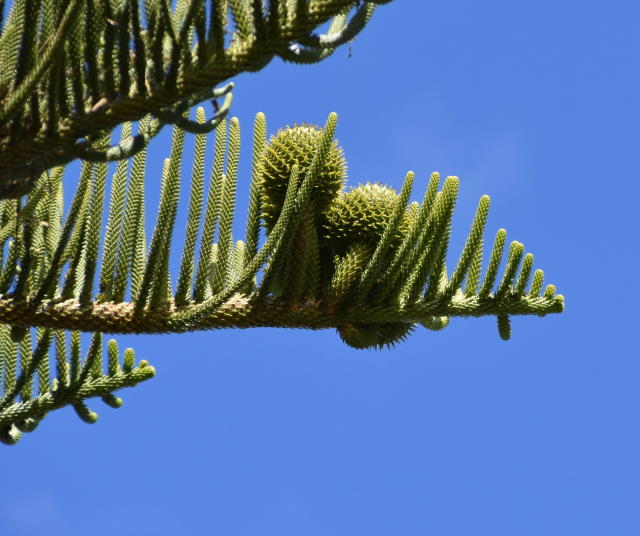
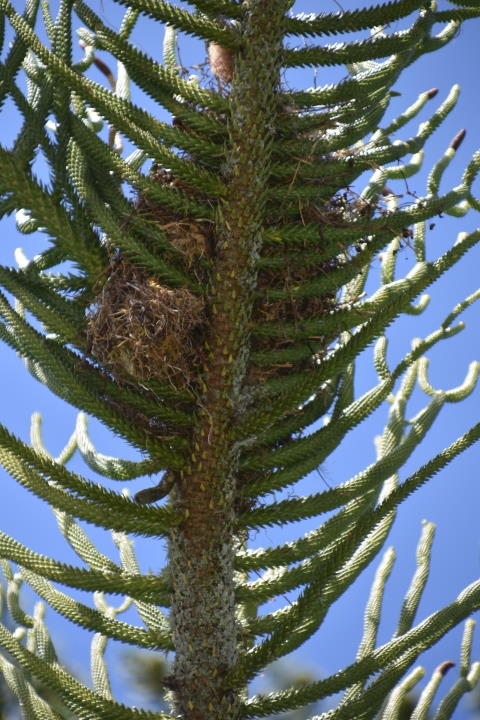
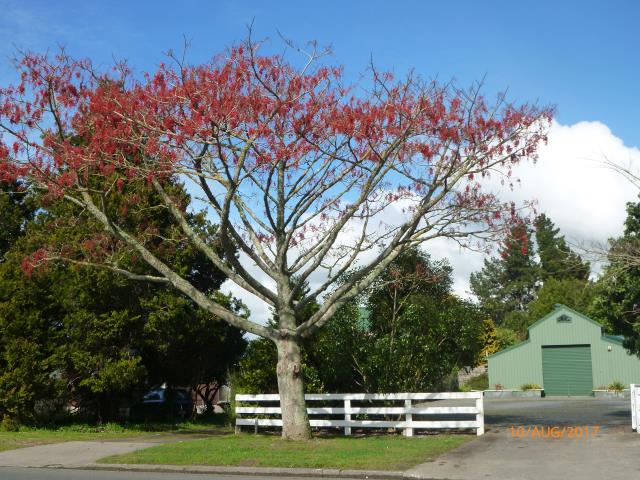
Chinese Wonder Tree
Bringing a splash of colour to our streets and gardens in winter, the Idesia originates in East Asia. It is a deciduous flowering plant, a member of the Salicaceae or willow family, growing to a height of about 25 metres. The flowers occur in panicles up to 30 cm long and are small, yellowish-green and truly insignificant. Male and female flowers occur on separate trees and the female flowers only are fragrant. Its large heart-shaped leaves turn a light yellow colour in autumn, but the spectacular drupes of bright red berries that adorn the female tree in winter are without doubt its most spectacular feature. This is shown to good effect on this Idesia outside the Cambridge Tree Trust depot in Thornton Road.
Although some sources claim the berries are unattractive to birds, they are apparently quite edible. Tree Trust members have observed with delight that in late winter the native pigeon (keruru) sometimes feed happily on the berries of the Idesia near the Tree Trust depot. Each berry has several brown seeds and these are usually spread by birds. The wood of the Idesia does not seem to have any material or medicinal uses.
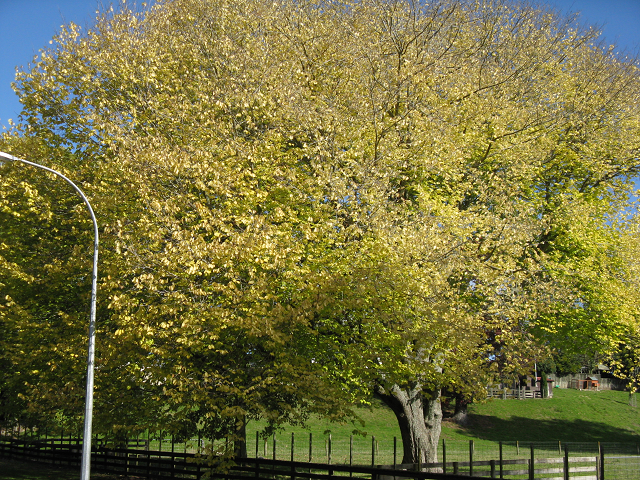
Ulmus procera ‘Louis van Houtte’
Planted extensively in gardens, parks and farms through out New Zealand, this golden form of the English elm never reaches the stature of its green parent, which can grow as tall as 45 metres. Decimated now in England by Dutch elm disease, they were once the glory of the English countryside, evoking nostalgia in the heart of many an Englishman or woman. Constable was constantly trying to capture the beauty of the elm in his paintings, although it is said his oaks were better than his elms! And in 1845 Robert Browning, in ‘Home Thoughts from Abroad’, wrote:
Oh, to be in England,
Now that April’s there,
And whoever wakes in England
Sees, some mornings, unaware,
That the lowest boughs and the brushwood sheaf
Round the elm-tree bole are in tiny leaf,
While the chaffinch sings on the orchard bough
In England – now!
We may doubt that our prevalent, rather garish, yellow variety will evoke such longing in the hearts of New Zealanders, but next October take a moment to sit under the specimen growing close to the clock tower in Victoria Street. It may not be tall but the spread of its branches is magnificent, and viewed from beneath in the late spring, before its leaves have yellowed, it forms a beautiful light green shade canopy, most calming to the soul.
We do have some examples of the true English elm; go to Te Ko Utu park where you can see a number of mutilated specimens on the bank. No doubt our Council staff, concerned with the tree’s reputation as the ‘widow-maker’ as it drops big branches without warning, would prefer the following jingle:
Elm hateth man
And waiteth.
Is there a connection here with the fact that elm is the traditional wood for coffins?
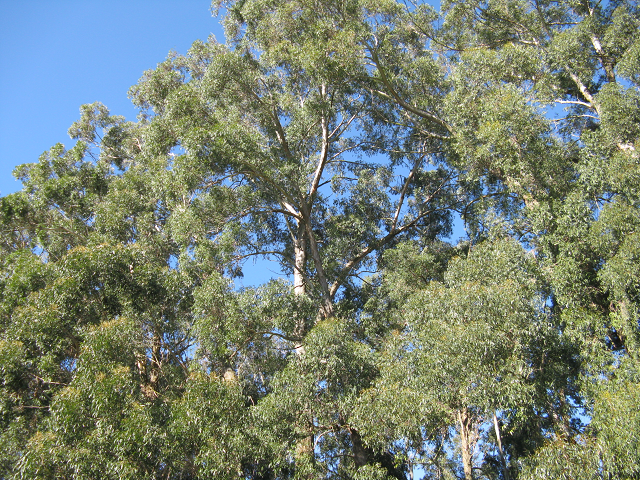
Eucalyptus species.
Cambridge is fortunate to possess several magnificent, towering stands of eucalyptus, along the river and in Te Ko Utu Park. Some of these trees may be over 100 years old. Identification of different species is difficult but the main ones present appear to be a stringybark, perhaps E. eugenoides, along with some Sydney blue gum, E. saligna. A remarkable all-purpose tree, eucalyptus wood is excellent for construction, flooring, joinery, panelling, furniture-making, outdoor decking, boatbuilding, fence posts, power poles and pulp for fine paper, while the oil has medicinal properties, and the nectar attracts honey bees.
The first eucalyptus trees in New Zealand were planted in 1836 by Rev James Hamlin at his mission station near the south head of the Manukau Harbour. They were possibly planted for their medicinal value since they dry up swamps where insects breed and exude insect-repelling oils. Some 60 years later Mother Mary Joseph Aubert was planting eucalyptus in the Whanganui river area for producing medicines to cure bronchitis and fevers, and Maori too had adopted their use for various ailments.
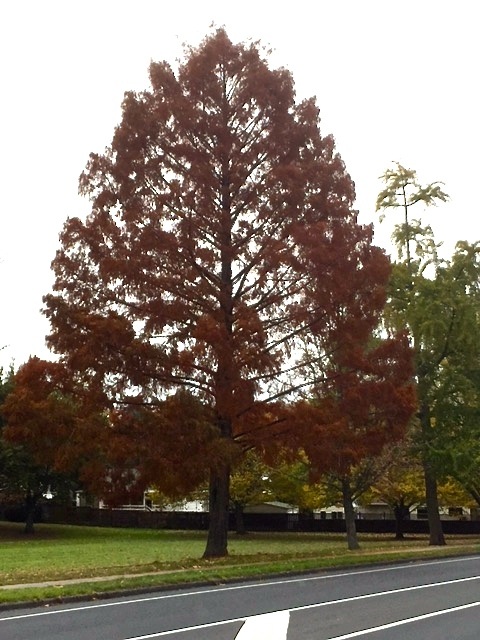
Metasequoia glyptostroboides
Now there is a Latin name that rolls of the tongue! This shapely, fast-growing deciduous conifer will grow to 200 feet. In spring it acquires beautiful light green ferny foliage, which then turns a coppery or amber colour in autumn. The one pictured here is to be found in Lauriston Park, Leamington; look out for others around the town but do not confuse it with the swamp cypress which is also a deciduous conifer with similar foliage.
The only remaining species of its genus, the dawn redwood is regarded as a living fossil. During the Mesozoic age when dinosaurs still roamed the Earth it was widespread, but was thought to have been extinct for at least 5000 years. And then in 1941 three of these trees were discovered half way up the Yangtze River in China. It is still endangered in its natural habitat; there are only small stands remaining in Sezchuan and Hubei provinces, where it is known as water larch and was often fed to cattle. Since 1948 seed-grown specimens have become widely distributed throughout other temperate areas of the world. It prefers to grow in damp sheltered sites and has become a popular tree for parks.
The Cambridge Tree Trust was registered with the Charities Commission as a Charitable Entity under the Charities Act 2005 on 16 August 2007. Registration No: CC10859

